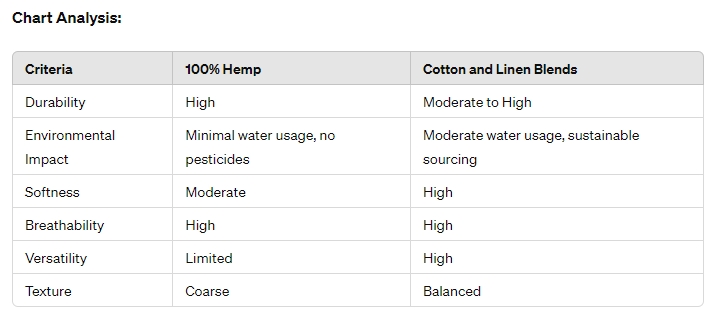Tel:+86-551-65134253 Email: [email protected]
Natural fibers like hemp, cotton, and linen have been valued for centuries for their unique properties and versatility in various industries, particularly textiles. When it comes to fabric choices, 100% hemp and cotton and linen blends stand out for their distinct characteristics. In this article, we'll delve into the advantages and disadvantages of both options and provide a comparative chart analysis for better insight.
**1. 100% Hemp:**
**Advantages:**
- **Durability:** Hemp fibers are exceptionally strong and durable, making hemp fabrics long-lasting and resistant to wear and tear.
- **Environmental Sustainability:** Hemp cultivation requires minimal water and no pesticides or herbicides, making it a highly sustainable option. Additionally, hemp plants improve soil health through phytoremediation.
- **Breathability:** Hemp fabrics allow for excellent airflow, making them suitable for warm climates or activities that induce perspiration.
**Disadvantages:**
- **Texture:** Some people find hemp fabric to be coarse or rough, especially in its natural, untreated state.
- **Limited Softness:** Compared to cotton and linen, hemp may lack the softness desired for certain applications, such as clothing worn directly against the skin.
**2. Cotton and Linen Blends:**
**Advantages:**
- **Softness:** Cotton and linen blends offer a balance between the softness of cotton and the texture of linen, providing a comfortable feel against the skin.
- **Breathability:** Like hemp, linen is highly breathable, allowing for excellent airflow and moisture-wicking properties, while cotton adds to the overall comfort.
- **Versatility:** Blending cotton and linen allows for a wide range of textures and finishes, making them suitable for various applications from clothing to home textiles.
**Disadvantages:**
- **Durability:** While linen is durable, cotton fibers may not be as strong as hemp, potentially reducing the overall durability of the fabric blend.
- **Environmental Impact:** Although linen is derived from the flax plant and is generally considered more sustainable than conventional cotton, it still requires water and energy for cultivation and processing.

**Conclusion:**
In conclusion, both 100% hemp and cotton and linen blends offer unique advantages and disadvantages, catering to different preferences and needs. 100% hemp stands out for its exceptional durability and environmental sustainability, albeit with a coarser texture. On the other hand, cotton and linen blends provide a softer feel while maintaining good breathability and versatility, although they may not be as durable as hemp.
When deciding between 100% hemp and cotton and linen blends, factors such as desired texture, durability, environmental impact, and intended use should be carefully considered. By weighing these factors and referencing the comparative chart analysis provided, individuals and businesses can make informed decisions regarding their fabric choices for various applications.
Anhui Kingson Household Products Co.,Ltd is good at producing 100% hemp quilts or bedding sets. Welcome to inquiry.
